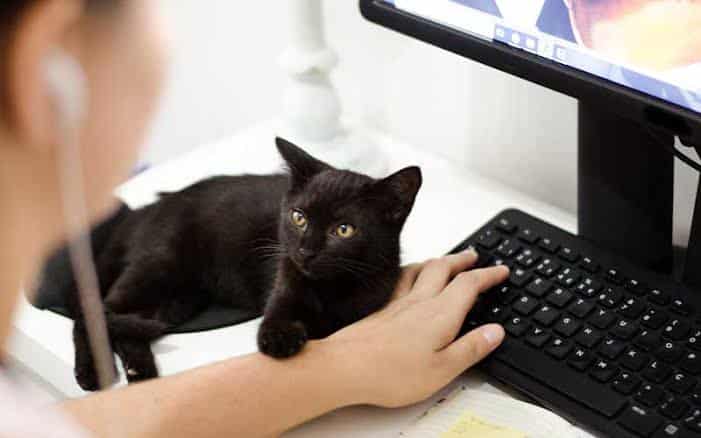Cats are known for their independence, but what happens when your cat becomes unusually clingy? If you’ve ever found yourself wondering, “Why Is My Cat So Clingy?” you’re not alone. Seek no further, as we will know all about that in this article.
What Is Clinginess In Cats?
Clinginess in cats refers to an excessive need for attention, affection, and proximity to their owners. While it’s natural for cats to seek out interaction and companionship, clinginess becomes apparent when these behaviors become persistent and intrusive. Understanding what constitutes clinginess in cats is essential for distinguishing between normal feline behavior and behavior that may indicate an underlying issue.
Recommended: Are Cats Smarter than Dogs?
Signs Of Clinginess
- Constant Following: A clingy cat may follow their owner from room to room, unwilling to be left alone.
- Demanding Attention: They may vocalize excessively, paw at their owner, or even exhibit behaviors like rubbing against legs or climbing onto laps persistently.
- Intrusive Behavior: Clingy cats may exhibit behaviors such as jumping onto countertops or desks, interfering with activities, or even attempting to prevent their owner from leaving the house.

Differentiating Clinginess from Affection
It’s important to note that clinginess in cats should be distinguished from normal displays of affection. While affectionate cats may enjoy spending time with their owners and seek out attention, clingy behavior is characterized by its intensity and persistence. Clingy cats often exhibit behaviors that interfere with their owner’s daily activities and may become distressed when unable to maintain close proximity.
Understanding The Root Causes
Several factors can contribute to clinginess in cats, including biological predispositions, environmental stressors, and emotional triggers. Identifying the underlying cause of your cat’s clinginess is crucial for addressing the behavior effectively and promoting their overall well-being.
Factors Contributing To Clingy Behavior Of Cats
Understanding the root causes of clingy behavior in cats involves exploring various factors that can influence their behavior. These factors can be broadly categorized into biological, environmental, and emotional triggers.
Biological Factors:
- Genetic Predispositions: Some cats may have a genetic predisposition towards clinginess. Certain breeds, such as Siamese or Burmese cats, are known for their affectionate nature and may be more prone to clinginess.
- Hormonal Changes: Fluctuations in hormone levels, such as those experienced during heat cycles or pregnancy, can affect a cat’s behavior and may contribute to clinginess.
Environmental Influences:
- Changes in the Household: Significant changes in the cat’s environment, such as moving to a new home, the arrival of a new pet or family member, or changes in routine, can trigger clingy behavior as the cat seeks reassurance and stability.
- Lack of Stimulation: Cats are curious and intelligent animals that require mental and physical stimulation to thrive. A lack of environmental enrichment, such as toys, scratching posts, or opportunities for play, can lead to boredom and clingy behavior as the cat seeks stimulation from their owner.
Emotional Triggers:
- Separation Anxiety: Cats, like humans, can experience separation anxiety when separated from their owners for extended periods. This anxiety can manifest as clingy behavior, vocalization, destructive behavior, or inappropriate elimination.
- Stressors in the Cat’s Life: Stressful events such as loud noises, changes in routine, or conflicts with other pets can trigger clingy behavior as the cat seeks comfort and security from their owner.
Recommended: Can Cats See Ghosts?
Understanding Triggers For Clinginess In Your Cat
Identifying the triggers for clingy behavior in your cat is essential for addressing the underlying causes and promoting a harmonious relationship between you and your feline companion. While every cat is unique, there are common triggers that may contribute to clinginess:
1. Changes In Routine
Cats thrive on routine, and disruptions to their daily schedule can cause stress and anxiety. Changes such as alterations in feeding times, rearranging furniture, or shifts in your work schedule can trigger clingy behavior as your cat seeks reassurance and stability.
2. Environmental Stressors
Environmental factors such as loud noises, construction work, or the presence of unfamiliar animals can create stress for your cat and lead to clingy behavior. Cats are sensitive creatures, and even seemingly minor disturbances can disrupt their sense of security.
3. Health Issues
Underlying health problems can also contribute to clingy behavior in cats. Pain, discomfort, or illness may cause your cat to seek comfort and attention from you as they attempt to alleviate their distress. It’s essential to monitor your cat’s overall health and consult with your veterinarian if you notice any changes in behavior.
4. Emotional Needs
Cats, like humans, have emotional needs that must be met for their well-being. Feelings of loneliness, boredom, or insecurity can drive clingy behavior as your cat seeks companionship and stimulation. Providing opportunities for interaction, play, and environmental enrichment can help fulfill your cat’s emotional needs and reduce clinginess.
5. Separation Anxiety
Some cats experience separation anxiety when left alone for extended periods. This anxiety can manifest as clingy behavior, vocalization, destructive behavior, or inappropriate elimination. Understanding your cat’s anxiety triggers and implementing strategies to alleviate their distress can help mitigate clinginess.

Tips And Strategies For Addressing Cat Clinginess
Dealing with a clingy cat can be challenging, but with the right approach, you can help alleviate their neediness and foster a more balanced relationship. Here are some practical tips and strategies to address cat clinginess effectively:
1. Provide Ample Physical And Mental Stimulation
Engage your cat in regular play sessions using interactive toys to satisfy their natural hunting instincts and provide mental stimulation.
Create a stimulating environment with scratching posts, climbing trees, and puzzle feeders to keep your cat entertained and mentally engaged.
2. Establish Routines And Boundaries
Set consistent feeding times, playtimes, and grooming sessions to establish a predictable routine that your cat can rely on.
Establish boundaries by ignoring attention-seeking behaviors such as meowing or pawing when they’re unwarranted, and only reward desirable behavior with attention and treats.
3. Create Safe Spaces
Provide your cat with designated safe spaces where they can retreat and relax when they need time alone.
Invest in cozy cat beds, hiding spots, or elevated perches where your cat can feel secure and comfortable.
4. Implement Gradual Departures And Returns
Help your cat feel more secure when you leave the house by implementing gradual departures and returns. Practice leaving for short periods and gradually increase the duration over time to desensitize your cat to your absence.
Leave comforting items such as worn clothing or blankets with your scent to provide reassurance in your absence.
5. Consider Professional Help
If your cat’s clinginess persists despite your efforts, consider seeking guidance from a veterinarian or animal behaviorist.
A professional can help assess your cat’s behavior, identify underlying issues, and provide tailored recommendations for managing clinginess effectively.
Recommended: Do Male Cats Go Into Heat?

FAQs
Is It Normal For Cats To Be Clingy?
While cats are often known for their independent nature, some cats can exhibit clingy behavior due to various factors such as genetics, environmental stressors, or emotional needs. While occasional clinginess is normal, persistent clinginess may indicate underlying issues that require attention.
How Can I Tell If My Cat Is Being Clingy Or Just Affectionate?
Clingy behavior in cats is characterized by its intensity and persistence. Signs of clinginess include constant following, demanding attention, and intrusive behavior. While affectionate cats may enjoy spending time with their owners, clingy cats may become distressed when separated and exhibit behaviors that interfere with daily activities.
What Are Some Common Triggers For Clingy Behavior In Cats?
Common triggers for clingy behavior in cats include changes in routine, environmental stressors such as loud noises or the presence of unfamiliar animals, underlying health issues, emotional needs such as loneliness or insecurity, and separation anxiety.
How Can I Help My Clingy Cat Feel More Secure?
Providing ample physical and mental stimulation, establishing routines and boundaries, creating safe spaces for your cat to retreat to, implementing gradual departures and returns, and seeking professional help if needed are effective strategies for addressing clinginess and helping your cat feel more secure.
When Should I Seek Professional Help For My Clingy Cat?
If your cat’s clinginess persists despite your efforts to address it, or if you notice any concerning changes in their behavior or health, it’s advisable to seek guidance from a veterinarian or animal behaviorist. A professional can help assess your cat’s behavior, identify underlying issues, and provide tailored recommendations for managing clinginess effectively.
Can Clinginess In Cats Be A Sign Of A Medical Problem?
Yes, clinginess in cats can sometimes be a sign of underlying health issues such as pain, discomfort, or illness. It’s essential to monitor your cat’s overall health and consult with your veterinarian if you notice any changes in behavior or if clinginess is accompanied by other concerning symptoms.
Recommended: Why Does My Cat Sleep At My Feet?
Conclusion
By recognizing the signs of clinginess, such as constant following, demanding attention, and intrusive behavior, you can differentiate between normal affection and behavior that may require intervention. Understanding the factors that contribute to clinginess, including biological predispositions, environmental stressors, and emotional needs, allows you to tailor your approach to address your cat’s specific needs effectively.
Implementing practical tips and strategies, such as providing ample stimulation, establishing routines and boundaries, creating safe spaces, and seeking professional help when needed, can help alleviate clinginess and promote your cat’s overall well-being.

